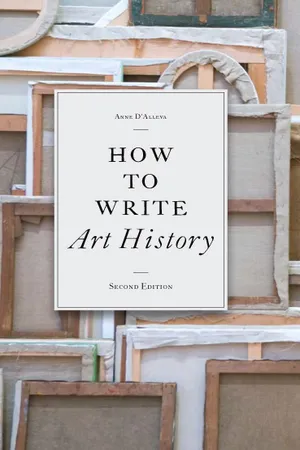
This is a test
- English
- PDF
- Available on iOS & Android
eBook - PDF
How to Write Art History Second Edition
Book details
Book preview
Table of contents
Citations
Frequently asked questions
At the moment all of our mobile-responsive ePub books are available to download via the app. Most of our PDFs are also available to download and we're working on making the final remaining ones downloadable now. Learn more here.
Both plans give you full access to the library and all of Perlego’s features. The only differences are the price and subscription period: With the annual plan you’ll save around 30% compared to 12 months on the monthly plan.
We are an online textbook subscription service, where you can get access to an entire online library for less than the price of a single book per month. With over 1 million books across 1000+ topics, we’ve got you covered! Learn more here.
Look out for the read-aloud symbol on your next book to see if you can listen to it. The read-aloud tool reads text aloud for you, highlighting the text as it is being read. You can pause it, speed it up and slow it down. Learn more here.
Yes, you can access How to Write Art History Second Edition by Anne D'Alleva in PDF and/or ePUB format, as well as other popular books in Art & Art Theory & Criticism. We have over one million books available in our catalogue for you to explore.
Information
Topic
ArtSubtopic
Art Theory & Criticismwhat
do
art
historians
do?
the
object
of
art
history
/
15
1.1
Barbara
Kruger,
Untitled
(
You
Invest
in
the
Divinity
of
the
Masterpiece
),
1982.
Photostat,
71
3
⁄
4
x
45
1
⁄
2
in
(182
x
116
cm).
The
Museum
of
Modern
Art,
New
York.
Kruger’s
words
frame
a
detail
of
the
Sistine
Chapel
ceiling
(the
ultimate
masterpiece)
that
represents
God
reaching
out
to
endow
Adam
with
life
(the
ultimate
act
of
creation).
Her
work
critiques
the
ways
that
masterpieces
are
‘made’:
we
as
a
culture
decide
to
invest
aesthetic
and
other
kinds
of
value
in
certain
works
even
as
we
devalue
others.
Table of contents
- Acknowledgements
- Introduction: How to use this book
- Chapter 1: Introducing art history
- Chapter 2: Formal analysis
- Chapter 3: Contextual analysis
- Chapter 4: Writing art history essays and papers
- Chapter 5: Navigating art history examinations
- Chapter 6: Art history's own history
- Glossary
- Bibliography
- Table of parallel illustrations in art history surveys
- Index
- Picture credits